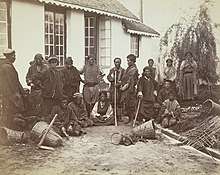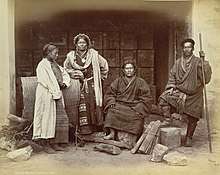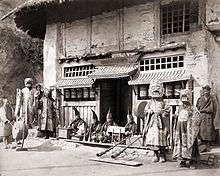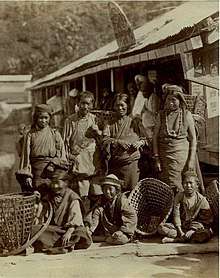Bhutia
The Bhutia (བོད་རིགས; Sikkimese: Drenjongpa / Drenjop ; Tibetan: འབྲས་ལྗོངས་པ་, Wylie: Bras-ljongs-pa ; "inhabitants of Sikkim"; in Bhutan: Dukpa) are a community of Sikkimese people of Tibetan ancestry, who speak Lhopo or Sikkimese, a Tibetan dialect fairly mutually intelligible with standard Tibetan. In 2001, the Bhutia numbered around 70,300. Bhutia here refers to Sikkimese of Tibetan ancestry; in contrast, the Bhotiya are a larger family of related Tibetan peoples in northeastern Nepal of which the Bhutia are one member group.

| Total population | |
|---|---|
| 70,300 (2001).[1] | |
| Regions with significant populations | |
| Languages | |
| Sikkimese, Nepali, Dzongkha, Tibetan | |
| Religion | |
| Buddhism, Bön | |
| Related ethnic groups | |
| Bhotiya, Sherpa people |

%2C_RP-F-00-5347-4A_(cropped).jpg)
Language
The language spoken by the Bhutias in Sikkim is Sikkimese, which is 85% mutually intelligible with Tibetan and Dzongkha, the language of Bhutan. Most Bhutias practice the Nyingma school, followed by the Kagyu school of Tibetan Buddhism. The Bhutias are spread out over Nepal, Bhutan, and the state of Sikkim and districts of Kalimpong and Darjeeling in India.
History
The ancestors of the Bhutia migrated from Tibet to north eastern Nepal, Sikkim, Darjeeling, Kalimpong, and other parts of modern-day Nepal, India and Bhutan. They migrated through the different passes ("La" in Tibetan means "hill") in the Himalayas. Geographical indications in the name of Bhutias' last names are common. In Northern Sikkim, for example, where the Bhutias are the majority inhabitants, they are known as the Lachenpas or Lachungpas, meaning inhabitants of Lachen (Tibetan: ལ་ཆེན་ ; "big pass") or Lachung (Tibetan: ལ་ཆུང་ ; "small pass") respectively.
Bhutia aristocrats were called Kazis after similar landlord titles in neighboring regions, especially in modern-day Bangladesh. This feudal system was an integral part of the Chogyal monarchy prior to 1975, when Sikkim was an independent monarchy; the ruling dynasty of the Kingdom of Sikkim before the mid-1970s plebiscite was the Bhutia Namgyal dynasty. Among the Bhutias, the Lachenpas and Lachungpas have their own traditional legal system called the "Dzumsa" which means the meeting place of the people. The Dzumsa is headed by the village headman known as the Pipon. People of North Sikkim have been given full protection by the state government by deeming a status of Panchayat ward and the Pipon, a status of Panchayat head.

Clothing
The traditional outfit of Bhutias is the bakhu (similar to the Tibetan chuba, but sleeveless), which is a loose cloak type garment fastened at the neck on one side and near the waist with a silk/cotton belt. Male members array the bakhu with loose trousers. Womenfolk wear the bakhu with a silken full sleeve blouse called a honju; a loose gown type garment fastened tight near the waist with a belt. In the front portion, a loose sheet of multicolored woolen cloth with exotic geometric designs is tied. This is called the pangden and is a symbol of a married woman. This traditional outfit is complemented by embroidered leather boots worn by both men and women.
Bhutia women enjoy a much higher status than their counterparts from other communities. Both women and men have a weakness for gold in its purest form and, traditional jewelry is mostly made of 24 carat (100%) gold.
Society
In Sikkim, the Bhutias are mostly employed in the government sector, in agriculture, and increasingly in the business arena as well. In the district of Darjeeling, Bhutias are often employed in government and commerce. Bhutias practise intermarriage within their clans and follow a very hierarchical system of bride and groom selection. Clan discrimination is widespread, and marriage outside the community is looked down upon.
Religion

The Bhutias are followers of Vajrayana Buddhism, mainly the Nyingma and Kagyu schools. The main festivals observed by them are Losar and Losoong. The first week of February is usually the time of Losar as it marks the start of the Tibetan New Year. Fire dances are common in the evenings during Losar. Losoong is usually celebrated as the end of the Tibetan year and falls at the end of the tenth Tibetan lunar month (usually December). It is the most important festival among the Bhutias in India, and is marked by the traditional Chaan dancing and merry-making. Losoong is celebrated across the monasteries in Bhutan, Nepal and India. In Sikkim, during the festival of Losoong, often dance forms depict narrativized tales from the life of Padmasambhava or Guru Ugyen.
Monasteries of the Bhutias dot various places in India, most notably the Rumtek Monastery in Sikkim and the Bhutia Busty Monastery or Karma Dorjee Chyoling Monastery, which is also the oldest Monastery in Darjeeling.
Hindu (Sharma) Bhutia
Bhutia is also the surname of Marwari people of Brahmin caste. They worship deity Ramdev Pir, Khatushyam and Salasar Balaji as Ishta-deva. Although historically associated with people of the Brahmin varnas, the name has been widely adopted by other communities.
Houses
A traditional Bhutia house is called a "khim" and is usually rectangular.
The Bhutias have a stone structure outside the house which is used for burning incense. It is called "sangbum." "Sang" means incense and "bum" means vase; the shape of the structure is like a vase. It is used for burning sang, a sacred offering to the deities. The deities are offered scented dried leaves/stalks of rhododendron anthopogon, juniperus recurva, rhododendron setosum or incense sticks made of pine.
Cuisine

Bhutia people traditionally eat rice with animal-fat-fried vegetables or meat, usually pork or beef, and occasionally mutton or chicken. Other well-known foods are momo, steamed meat dumplings, and the thukpa, noodles in broth. The Losar and Loosong are two among many festivals celebrated by the Bhutia community. Almost all Bhutia festivals and holidays hold Buddhist religious significance. They are also known to utilize over 70 species of animal, fungi, and plant.[2] Chhaang is the favourite drink of the Bhutias, and increasingly of other communities coexisting with the Bhutias. It is made of fermented barley or millet, and served in a bamboo container called the Tongba. Tea with milk and sugar, and butter tea, are also served on religious or social occasions.
Arts, crafts, and music
The Bhutia have a rich tradition of dances, songs, and folktales. The popular Bhutia folk dances are Denzong-Neh-Na, Ta-Shi-Yang-Ku, Tashi Shabdo, Guru-Chinlap, Singhi Chham and Yak Chham.[3]
Musical instruments used are Flute, Yangjey, Drum and Yarka.[3]
Status within India
.jpg)
Within the Dominion of India, the Bhutias as recognized as Scheduled Tribes in the states of Sikkim, West Bengal and Tripura.[4]
On August 26, 2015, during her visit to Darjeeling, the Mamata Banerjee led West Bengal Government, announced the formation of a separate development board for the Bhutia community.[5]
Notable Bhutias
- Bhaichung Bhutia - former national football captain
- Samten Bhutia - film director and writer
- Danny Denzongpa - Bollywood actor
- Palden Bhutia - Investor
- Ganju lama VCMM
- Nadong Bhutia
See also
- Vajrayana Buddhism
- Sikkimese language
- Indigenous peoples of Sikkim
References
- Lewis, M. Paul, ed. (2009). "Sikkimese". Ethnologue: Languages of the World (16th ed.). Dallas, Texas: SIL International. Archived from the original on 14 May 2011. Retrieved 2011-04-16.
- O'Neill, Alexander; et al. (2017-03-29). "Integrating ethnobiological knowledge into biodiversity conservation in the Eastern Himalayas". Journal of Ethnobiology and Ethnomedicine. 13 (21). doi:10.1186/s13002-017-0148-9. PMC 5372287. PMID 28356115. Retrieved 2017-05-11.
- "Bhutia Folk Dances". Official website of Sikkim Tourism.
- "State/Union Territory-wise list of Scheduled Tribes in India". Ministry of Tribal Affairs, GOI. Archived from the original on 2016-08-15. Retrieved 2015-09-19.
- "Now, Mamata announces a Bhutia dev board". The Statesman, Kolkata. Retrieved 2015-09-19.
Further reading
- Bareh, Hamlet (2001). "The Sikkim Communities". Encyclopaedia of North-East India: Sikkim. Mittal Publications. ISBN 81-7099-794-1.
